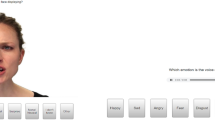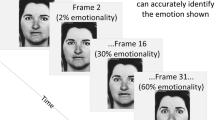Abstract
Two studies are presented that evaluate emotion recognition accuracy and interpretative processing of facial expressions in relation to depressive symptoms in women. Dysphoric women more often attributed themselves as the cause of negative expressions, more often made negative interpretations of others’ thoughts, and had more negative thoughts about themselves when viewing facial expressions. However, dysphoric women were not less accurate or rapid in recognizing facial expressions. An integrative model, the “levels of self-processing view,” is discussed as a synthesis of the results across studies. Limitations of the current studies and future research directions are discussed.
Similar content being viewed by others
References
Abramson, L. Y., Metalsky, G. L., & Alloy, L. B. (1989). Hopelessness depression: A theory based subtype of depression. Psychological Review, 96, 358–372.
Archer, J., & Hay, D. C. (1992). Face processing in psychiatric conditions. British Journal of Clinical Psychology, 31, 45–61.
Beck, A. T., Steer, R. A., & Brown, G. (1996). Beck Depression Inventory Manual (2nd ed.). San Antonio, TX: Psychological Corporation.
Bouhuys, A. L., Geerts, E., Mersch, P. P. A., & Jenner, J. A. (1996). Nonverbal interpersonal sensitivity and persistence of depression: Perception of emotions in schematic faces. Psychiatry Research, 64, 193–203.
Bouhuys, A. L., Geerts, E., & Gordijn, C. M. (1999a). Gender-specific mechanisms associated with outcome of depression: Perception of emotions, coping and interpersonal functioning. Psychiatry Research, 85, 247–261.
Bouhuys, A. L., Geerts, E., & Gordijn, C. M. (1999b). Depressed patients perceptions of facial emotions in depressed and remitted states are associated with relapse: A longitudinal study. Journal of Nervous and Mental Disease, 187, 595–602.
Bouhuys, A. L., Geerts, E., & Mersch, P. P. A. (1997). Relationship between perception of facial emotions and anxiety in clinical depression: Does anxiety related perception predict persistence of depression? Journal of Affective Disorders, 43, 213–223.
Bradley, B. P., Mogg, K., Millar, N., Bonham-Carter, C., Fergusson, E., Jenkins, J., & Parr, M. (1997b). Attentional bias for emotional faces. Cognition & Emotion, 11, 25–42.
Bradley, B. P., Mogg, K., Falla, S. J., & Hamilton, L. R. (1998). Attentional bias for threatening facial expressions in anxiety: Manipulation of stimulus duration. Cognition & Emotion, 12, 737–753.
Bradley, B. P., Mogg, K., & Millar, N. H. (2000). Covert and overt orienting of attention to emotional faces in anxiety. Cognition & Emotion, 14, 789–808.
Kendall, P. C., Hollon, S. D., Beck, A. T., Hammen, C. L., & Ingram, R. E. (1987). Issues and recommendation regarding the use of the Beck Depression Inventory. Cognitive Therapy & Research, 11, 289–299.
Mogg, K., Millar, N., & Bradley, B. P. (2000). Biases in eye movements to threatening facial expression in generalized anxiety disorder and depressive disorder. Journal of Abnormal Psychology, 109, 695–704.
Burns, D. D. (1980). Feeling good. New York: Penguin.
Carton, J. S., Kessler, E. A., & Pape, C. L. (1999). Nonverbal decoding skills and relationship well-being in adults. Journal of Nonverbal Behavior, 23, 91–100.
Cooley, E. L., & Nowicki, S. (1989). Discrimination of facial expressions of emotion by depressed subjects. Genetic, social, and General Psychology Monographs, 115, 451–465.
Crews, W. D., & Harrison, D. W. (1994). Sex differences and cerebral asymmetry in facial affect perception as a function of depressed mood. Psychobiology, 22, 112–116.
Dozois, D. J. A., Dobson, K. S., & Ahnberg, J. L. (1998). A psychometric evaluation of the Beck Depression Inventory-II. Psychological Assessment, 10, 83–89.
Ekman, P., & Friesen, W. V. (1976). Pictures of facial affect. Palo Alto, CA: Consulting Psychologists Press.
Feinberg, T. E., Rifkin, A., Schaffer, C., & Walker, E. (1986). Facial discrimination and emotional recognition in schizophrenia and affective disorders. Archives of General Psychiatry, 43, 276–279.
Geerts, E., & Bouhuys, N. (1998). Multi-level prediction of short-term outcome of depressions: Non-verbal interpersonal processes, cognitions and personality traits. Psychiatry Research, 79, 59–72.
Gessler, S., Cutting, J., Frith, C. D., & Weinman, J. (1989). Schizophrenic inability to judge facial emotion: A controlled study. British Journal of Clinical Psychology, 28, 19–29.
Gotlib, I. H., Kasch, K. L., Traill, S., Joorman, J., Arnow, B. A., & Johnson, S. L. (2004). Coherence and specificity of information-processing biases in depression and social phobia. Journal of Abnormal Psychology, 113, 386–398.
Gotlib, I. H., Krasnoperova, E., Yue, D. N., & Joormann, J. (2004). Attentional biases for negative interpersonal stimuli in clinical depression. Journal of Abnormal Psychology, 113, 127–135.
Gur, R. C., Erwin, R. J., Gur, R. E., Zwil, A. S., Heimberg, C., & Kraemer, H. C. (1992). Facial emotion discrimination: II. Behavioral findings in depression. Psychiatry Research, 42, 241–251.
Hale, W. W. (1998). Judgement of facial expressions and depression persistence. Psychiatry Research, 80, 265–274.
Hale, W. W., Jansen, J. H. C., Bouhuys, A. L., & Hoofdakker, R. H. (1998). The judgment of facial expressions by depressed patients, their partners and controls. Journal of Affective Disorders, 47, 63–70.
Ingram, R. E. (1990). Self-focused attention in clinical disorders: Review and a conceptual model. Psychological Bulletin, 107, 156–176.
Joiner, T. E., Jr., & Coyne, J. C. (Eds.). (1999). The interactional nature of depression: Advances in interpersonal approaches. Washington, DC: American Psychological Association.
Mandal, M. K., & Palchoudhury, S. (1985). Responses to facial expression of emotion in depression. Psychological Reports, 56, 653–654.
Mikhailova, E. S., Vladimirova, T. V., Iznak, A. F., Tsusulkovskaya, E. J., & Sushko, N. V. (1996). Abnormal recogniton of facial expression of emotions in depressed patients with major depression disorder and schizotypal personality disorder. Biological Psychiatry, 40, 697–705.
Persad, S. M., & Polivy, J. (1993). Differences between depressed and nondepressed individuals in the recognition of and response to facial expressions. Journal of Abnormal Psychology, 102, 358–368.
Pyszczynski, T., & Greenberg, J. (1987). Self-regulatory perseveration and the depressive self-focusing style: A self-awareness theory of the development and maintenance of depression. Psychological Bulletin, 102, 122–138.
Rubinow, D. R., & Post, R. M. (1992). Impaired recognition of affect in facial expression in depressed patients. Biological Psychiatry, 31, 947–953.
Russell, J. A., Bachorowski, J., & Fernandez-Dols, J. (2003). Facial and vocal expressions of emotions. Annual Review of Psychology, 54, 349–359.
Walker, E., McGuire, M., & Bettes, B. (1984). Recognition and identification of facial stimuli by schizophrenics and patients with affective disorders. British Journal of Clinical Psychology, 23, 37–44.
Winton, E. C., Clark, D. M., & Edelmann, R. J. (1995). Social anxiety, fear of negative evaluation, and the detection of negative emotion in others. Behavior Research & Therapy, 33, 193–196.
Zuroff, D. C., & Colussy, S. A. (1986). Emotion recogniton in schizophrenic and depressed inpatients. Journal of Clinical Psychology, 42, 411–417.
Author information
Authors and Affiliations
Corresponding author
Rights and permissions
About this article
Cite this article
Frewen, P.A., Dozois, D.J.A. Recognition and Interpretation of Facial Expressions in Dysphoric Women. J Psychopathol Behav Assess 27, 305–315 (2005). https://doi.org/10.1007/s10862-005-2410-z
Accepted:
Issue Date:
DOI: https://doi.org/10.1007/s10862-005-2410-z




